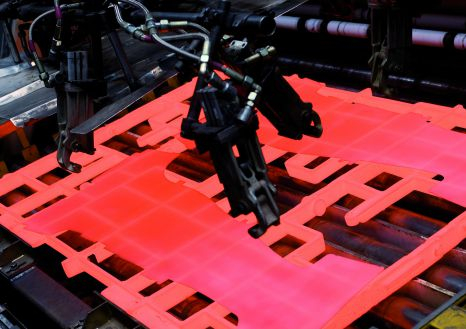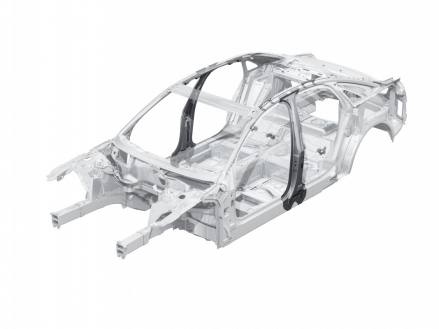Hot-shaped steels
A number of steel bodies from Audi, from the A1 (Combined fuel consumption in l/100 km: 7.1 – 3.8; Combined CO2-emissions in g/km: 162 – 99)** to the A7 Sportback, comprise significant proportions of high- and ultra high-strength steels of different strength classes. The best of these are the hot-shaped steels, which stand out due to their extreme tensile strength and the resulting weight-savings potential.
Many hot-shaped steel components – most of the B-pillars, for instance – are fabricated in-house. Two natural gas-fired furnaces, each measuring 23 meters (75.46 ft) long, are installed at Press Shop South in Ingolstadt. A robot gripper places the steel plate on an article carrier at the entrance to the furnaces. Ceramic rollers carry the plate through the furnace in under four minutes, during which time the plate is heated to over 920 degrees Celsius (1,688 degrees Fahrenheit). At the furnace exit, a gripper arm rapidly places the red-hot plate into a hydraulic press that works with a closing force of more than 600 tons. Cooling tubes through which cold water flows are cast into the die of the press, and the panel is cooled to approximately 180 degrees Celsius (356 degrees Fahrenheit).
The martensitic structure thus formed has an extremely high tensile strength of up to 1,500 megapascals – the same as the cables of a suspension bridge. A single wire with a cross-section of one square millimeter can suspend a weight of 150 kilograms (330.69 lb). It is so strong that it can only be machined using a laser or a diamond-edged tool. The B-pillars are partially hardened and tempered to purposefully influence the deformation characteristics. In a side-impact collision, the pillars deform more at the bottom than at the top in order to dissipate energy from the impact in a targeted manner.
Hot-shaped steels are used in most Audi models, starting with the A1. In the A6 (Combined fuel consumption in l/100 km: 9.6 – 4.4; Combined CO2-emissions in g/km: 225 – 114)** and A7, they form a protective cage of sorts for the passengers. They can be found in the transition from the front section of the car to the passenger cell, in the A-pillars and the roof arch, as reinforcements for the center tunnel and the side sills, at the transition of the side sills to the rear section of the car, as cross-bracings in the floor panel and as B-pillars. In the ASF of the Audi A8, hot-shaped steels also serve as the B-pillars, making the passenger cell even stronger and safer.
In models such as the new A6 and the Q5, Audi uses high-tech components – tailored blanks – in a number of areas, including the front-wall bulkhead and the floor panel. Tailored blanks are panels of various thicknesses. Tailored rolled blanks have undergone a roll-forming process to achieve the required thickness.
**Figures depend on the tires/wheels used.
Status: 2011

